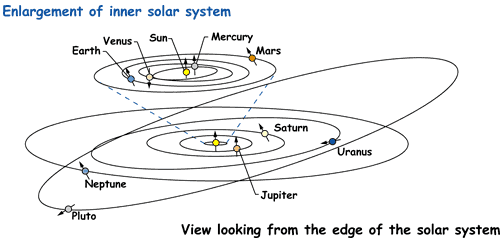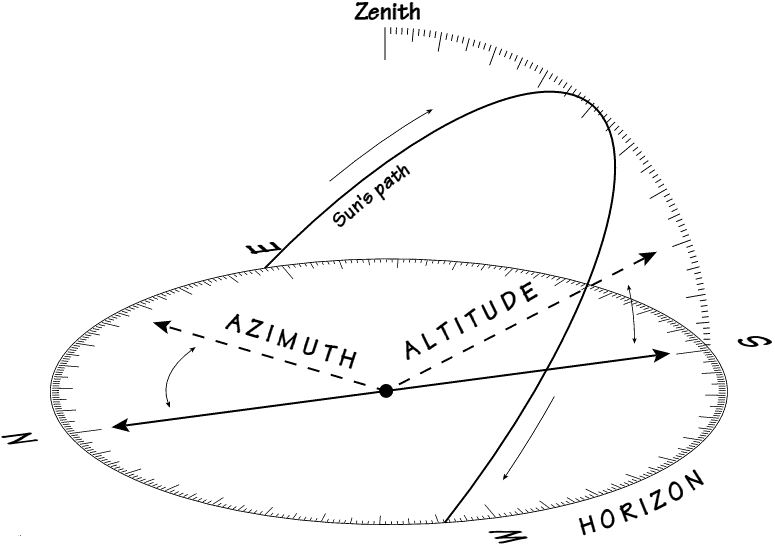Grok Astrophysics Q & A
a solar perspective
Shooting pictures of a fixed object from the surface of a rotating ball.

http://spaceplace.nasa.gov/review/ice-dwarf/SolarSystem_side.en.gif

http://www.spaceacademy.net.au/library/notes/axialorien.htm

Image on the left taken shortly after sunrise 8-22-2015. Image on the right taken shortly before sunset 8-22-2015. The two images were taken approximately 12 hours apart from Kiowa, CO., which is approximately 39.3 degrees North latitude, a month away from the Fall equinox when the Northern and Southern hemispheres will be equidistant from the Sun. Even though equidistant, the tilt of the Earth’s axis of rotation remains 23.5 degrees off plumb with the plane of the Earth’s ecliptic around the Sun.
Note the apparent shift in position and orientation of the sunspots, and consider how the Earth must rotate in the course of a 12 hour period to explain this change in view of these relatively fixed sunspots. The Sun’s own rotation of 25 Earth days at the Sun’s equator, and the Earth’s revolution period of 365 days around the Sun in the same direction of the Sun’s rotation do not explain the apparent clockwise 12 hour rotation of this sunspot group on the Sun. The Earth’s own rotation partially explains it.
http://solarscience.msfc.nasa.gov/SunspotCycle.shtml
To rule out sunspot movement, the next photo from the following morning shows the orientation of the sunspots back as they were, except for the rightward shift from the solar “day” rotation. So these sunspots are a relatively fixed point to compare against. Next – images at 3 hour intervals.





Turns out I introduced sunspot rotation over the course of the day by my reorientation of the camera to remain perpendicular to the horizon. Had the camera been kept on the same plane – on a constant azimuth – throughout the day, only changing its altitude to track on the Sun, the sunspots would not appear to rotate. In other words, changing the azimuth – or compass heading – of the shots, to compensate for the Earth’s rotation, caused the apparent rotation of the sunspot.

We see different lit phases of the Moon, however its rotation coincides with its orbit of the Earth and it always presents the same face to us – it’s a very apparent marker in the sky that doesn’t tell us anything about ourselves.
The Sun is too intense to observe with the naked eye, so the visual cues that indicate how we turn upside down each day aren’t readily apparent. But the evidence from these solar-filtered photos can change one’s perspective.
science vs. nonsense
People engaged in practicing scientific methods came to the Society of Exploration Geophysicist‘s [SEG] annual meeting and exhibition this week in Denver. They came to talk about all aspects of the science that uses imaging techniques for virtual simulations of the composition of the earth below the sea floor, below dry land, and below the sandy shallow shorelines. They brought examples of many of their tools for gathering the data to build the simulations – at least the tools that could fit on a semi truck, including a few as big as a semi truck. They brought a full library of reference books that SEG publishes and sells to anyone in the general public. They brought supercomputers built with arrays of CPU cores and stacks of graphics processors cabled into large racks to form co-processing centers capable of petaflop processing speeds. They brought software experts to manipulate datasets hundreds of terabytes in size through exotic transformations and functions for improving, interpreting, visualizing, dissecting, and representing the reflected seismic data vibrations gathered from massive tracts of potential energy-bearing geologic structures. They came to share their passion about their good fortune to be engaged in solving real and interesting problems using state of the art technology for the tangible benefit of mankind.
Last Sunday this technological frontier was out of sight and out of my mind. I hold our mass broadcast media responsible for that condition. Shame on those media content providers who evidently think the only thing interesting to talk about with regard to energy production is the latest bunch of creepy counter culture dregs carrying hand lettered signs with hyperbolic messages about how we’re all going to die from fracking.

Sure. We’re all going to die. You can’t seriously argue against that proposition. But the scientists exploring for energy actually push that day further out into the future for all of us. Geophysicists take on the hard challenge, the difficult question that requires years of education to successfully answer. Meanwhile, fractivists scribble up a few signs, organize their community of activists from the Left, and show up.
What do fractivists do for the betterment of mankind? That’s right. They show up. They occupy space. They “be.” And the media sends out their heavy satellite dish trucks to record the drama as news, to crowd out real information from the airwaves with an endless stream of meaningless pablum that will never build anything, inspire anyone, or improve our existence.
That’s why you have young kids stealing a couple thousand dollars from their parents’ credit cards to buy a ticket for Istanbul to go join some jihadi who will put an AK47 into their hands and add meaning to their empty existence. The kids know on some level that the world has amazing and fulfilling human endeavors in it, but they don’t know where to find them. So terrible forces move into those vacuums of meaning.
Educators and communicators steeped in Marxism for the last 40 years don’t dwell on real accomplishments because those events don’t politically empower the counter culture. Things like geophysics make the counter culture look silly, laughable, a waste of time and energy – all very disempowering characterizations. With Denver hosting a ground-zero event for worldwide oil and gas exploration – an evil incarnate population of engineers to a fractivist – not a single fractivist showed up to object at the Colorado Convention Center. Real meaning is kryptonite to them. Even geologist Governor Hickenlooper stayed away, perhaps not wishing to offend one of his Gang of Four deep pockets.
While geophysicists improve the world, the chattering classes spin their tales of Ebola, head chopping jihadis, financial collapse, wreckages of all sizes and shapes, storms and climate changes, victimization dramas, and politicians frame one hot mess after another with instant interpretations that always end with a moral that improves their side, their position. A cascade of false narratives give the Left the power to destroy, and power is what they live for. Disempowering the Left is the most politically incorrect thing one can do. Disempowering the Left is so wrong that the Left brand it with the most deplorable label imaginable – racism.
Don’t let the Left consume any more young people with destructive power. The Left squandered their franchises in the schools, the universities, and the media with false narratives, false dilemmas and false analyses.
It’s time our educators and communicators focused on the creators, those who accomplish the hard solutions from the difficult problem sets, the ones who tangibly improve mankind and don’t just talk about it.
Leave the dramas that empower the Left in the past. I doubt we ever needed their monkeyshines, but surely we don’t need them now.
